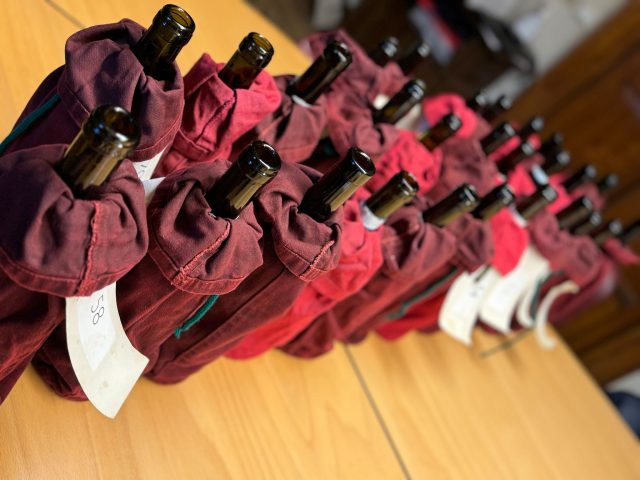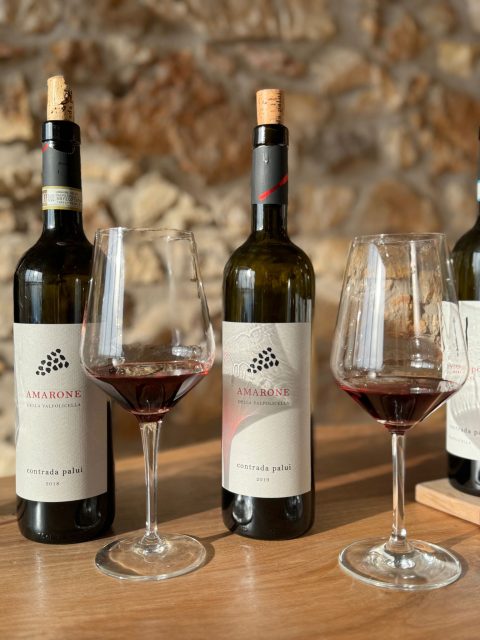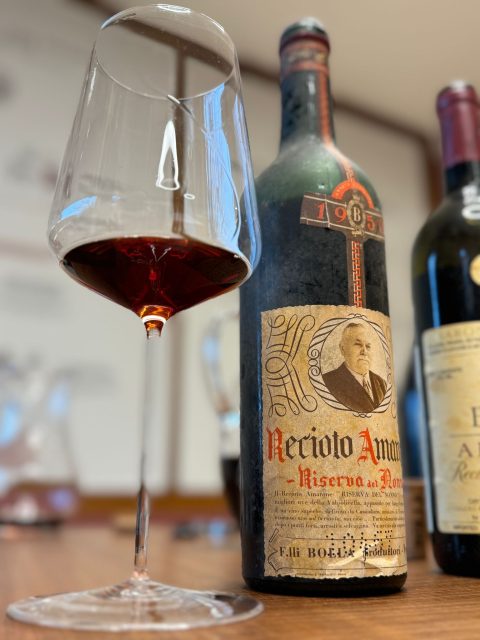This website uses cookies so that we can provide you with the best user experience possible. Cookie information is stored in your browser and performs functions such as recognising you when you return to our website and helping our team to understand which sections of the website you find most interesting and useful.
Amarone’s new wave: rethinking tradition
Filippo Bartolotta delves into how the “structured”, “full-bodied” and “powerful” wines of Amarone della Valpolicella DOCG are shifting towards a smoother style.

We all hold certain expectations for an Amarone di Valpolicella: a structured, full-bodied wine with a powerful sip, typically sweet, alcoholic, and dense. These defining characteristics have made Amarone recognizable and successful worldwide since the Nineties, propelled by talented winemakers with commercial acumen and appassimento expertise. However, the market landscape has shifted. Consumer preferences in this new millennium are evolving, leaning towards a more “easy-going” approach compared to three decades ago.
Winemakers in Valpolicella, who themselves are consumers, recognize this shift and are reevaluating methods, timing, and processes in vineyards and wineries to reclaim the market appeal of their most important red wine. According to Andrea Lonardi MW, an expert in the Amarone territory, the path to regaining consumer interest involves a shift from quantity to quality production, transitioning from controlling leadership to prestige, embracing new markets and communication strategies, and adapting winery practices to address the challenge of global warming.
Moreover, there’s an opportunity for Amarone to become a sought-after collectible wine. J.C. Viens, a seasoned wine educator and market expert, highlights the potential convergence of Amarone’s intrinsic value and the growing interest in Italian wines beyond traditional regions like Piedmont and Tuscany. Veneto, with its rising prominence, presents a unique chance for Amarone producers to position their wines as collectibles.
Interestingly, amid this evolution, some Valpolicella producers have pursued alternative approaches, emphasising specific terroirs, grape varieties, and gentler winemaking techniques. This ‘New Wave’ of producers is gradually reshaping the appellation’s landscape, offering Amarone wines that prioritise elegance and finesse over density and power.
An apt comparison can be drawn between this changing style and the contrast between Arnold Schwarzenegger and tennis champion Jannik Sinner: static muscularity versus agile strength. Similarly, Amarone’s evolution involves maintaining strength while gaining smoothness and finesse by viewing the appassimento process as a grape resistance journey, which adds complexity, rather than merely sugar concentration.
Spirit of innovation
Leading the charge towards this new approach are both larger and smaller wineries. While larger businesses can dedicate resources to this shift while maintaining broader market appeal, smaller wineries often pioneer these changes, taking risks and challenging conventions. The latter includes producers like Contrada Palui, Corte Rugolin, Corte Sant’Alda, Monte dall’Ora, Rubinetti Vajol, and Secondo Marco. They exemplify this innovative spirit, offering wines that defy Amarone’s traditional boldness in favour of freshness, lightness, and flavor complexity.
Before the 2024 Amarone Opera Prima, I visited each and every one of them, noticing that their Amarone either showed a much lower residual sugar than the 9 grams per litre allowed by the appellation, or a relatively lower alcohol content, never exceeding 15-15.5%.
Marco Speri has been making a point of producing a contemporary style Amarone since the foundation of his winery in 2008, calling it Secondo Marco, meaning “according to Marco”, aiming for a “light and refreshing style of Valpolicella and Amarone like we used to make in the 70s,” as he put it.
The new winery to watch is Contrada Palui, with Hans Pichler showcasing a delightfully transparent and vibrant 2018 Amarone with only 0.8 g/l of residual sugar: “I am only bringing home what nature gives me at 500m above sea level, which is very light red-driven fruit with an intense acidity that I love!”
Nicola Scienza of Rubinelli Vajol opted not to write ‘Amarone’ on his label with a capital ‘A’: “I wanted to underline how your wine doesn’t want to be too big and bold but rather a very easy to drink wine without giving up complexity and the Valpolicella Classica sense of place. We are happy that there’s more attention given to this style of wines as I remember not too long ago my ‘amarone’ wasn’t appealing to some very important Northern European importers, but now that’s what they ask for!”

Big players
And while the smaller wineries are marching towards this more refreshing style, which is making many young sommeliers all over the world burst with joy and excitement, I think we also need to be very aware of the importance the larger wineries are having on the entire appellation. Bertani has always been a reference point for this style of less opulent and more elegant Amarone, and its old vintage collection is an undeniable documentation of elegant Amarone with little residual sugar and low alcohol.
The same goes for another pioneer winery like Bolla, owned by one of Italy’s larger players, Gruppo Italiano Vini (GIV). Bolla’s winemaker, Christian Zulian, is convinced that Amarone della Valpolicella can not only be made basically as a dry wine with 15% alcohol, but that he wouldn’t know how to do it otherwise: “I do not like to leave residual sugar and malo in my wines. I make sure malolactic takes place correctly before fining the wines and my residual sugar is always below 1g/l (as a matter of fact around 0.4).”
Famiglia Pasqua Cascina San Vincenzo Amarone della Valpolicella is another example of Amarone moving towards a lighter and easier drinking attitude without giving up smoothness, roundness, and volume. I have been tasting from this wine from the big botti for quite a few years now with their winemaker Carlo Olivari and owner Riccardo Pasqua. I still remember the two of them offering some of the first samples with pride and joy, just like two boys who just invented a new toy: “so what do you think?” I taste: transparent ruby color, sour cherries, liquorice, eucalyptus and some balsamic notes and a crunchy red currant palate with a propolis-like finish, delicious! Seeing one of the oldest and largest players of Valpolicella moving towards this direction means that so many people will be able to get hold of these newer styles.
Camilla Rossi Chauvenet of Massimago adds: “A few years ago, when I was going out with my girlfriends, I remember nobody ever felt there was a moment to drink Amarone. Since then, I promised myself to focus on producing something easier to drink and more approachable. That’s why we have also played with more down-to-earth and contemporary style labels. I believe the image has to reflect the product!”
My last visit was a vertical tasting of Sartori Amarone della Valpolicella I Saltari, produced following a very low yield approach – not in order to extract more, but rather to enhance terroir. I get to the winery bringing with me Contrada Palui and Rubinelli Vajol Amarone and I ask if they are in the mood for a blind tasting. Andrea Sartori tasted the wines, smiled at me, and said: “We are going back to the original formula.”
Just as the original ‘New Wave’ movements of the seventies reshaped various industries, a change in Amarone style has the potential to disrupt the entire Valpolicella system. This shift invites contemplation: are we witnessing a true ‘New Wave’, a return to origins, or a fusion of past and present?
During my last trip to Valpolicella I cracked open a few older bottles of Amarone and I’m convinced that what’s happening now is a return to the origins. A couple of these wines show a clear picture of how recent Amarone della Valpolicella is paying a tribute to the classic older, and still wonderful, vintages.
Old vintage example 1

Amarone della Valpolicella Bolla 1950 is a delicious wine with bright red fruit, orange peel, fennel seeds, basil and a delightful tea-tree oil complexity. The palate is light and uplifting with so much juiciness and energy – it’s impossible not to drink it! Alcohol is 12.64%, and the residual sugar only 1.84g/l!
Old vintage example 2
Amarone della Valpolicella Bertani 1964 is a wonderful example of how the subtlety of dry flowers and warm spices blend with plums, cherries and liquorice with a gentle acidity and with a lingering finish. Great fine wines still alive and kicking with an easy to drink and yet complex style: and this adds more intrigue and excitement to the future of Amarone production. Alcohol is 15% and the residual sugar 3.2g/l.
Embracing the shift
In conclusion, Amarone’s evolving style reflects a nuanced response to changing consumer preferences, environmental challenges, and market dynamics. Embracing this shift requires a willingness to challenge tradition while preserving the essence of what makes Amarone unique. It’s a journey of rediscovery and reinvention – a journey that invites us to rethink, reimagine, and rediscover Amarone della Valpolicella.
Related reading:

